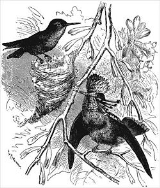
Tufted Coquette
Encyclopedia

Hummingbird
Hummingbirds are birds that comprise the family Trochilidae. They are among the smallest of birds, most species measuring in the 7.5–13 cm range. Indeed, the smallest extant bird species is a hummingbird, the 5-cm Bee Hummingbird. They can hover in mid-air by rapidly flapping their wings...
that breeds in eastern Venezuela
Venezuela
Venezuela , officially called the Bolivarian Republic of Venezuela , is a tropical country on the northern coast of South America. It borders Colombia to the west, Guyana to the east, and Brazil to the south...
, Trinidad
Trinidad
Trinidad is the larger and more populous of the two major islands and numerous landforms which make up the island nation of Trinidad and Tobago. It is the southernmost island in the Caribbean and lies just off the northeastern coast of Venezuela. With an area of it is also the fifth largest in...
, Guiana
The Guianas
The Guyanas or the Guianas refers to a region in north-eastern South America which includes the following three territories:* French Guiana, an overseas department of France;...
and northern Brazil
Brazil
Brazil , officially the Federative Republic of Brazil , is the largest country in South America. It is the world's fifth largest country, both by geographical area and by population with over 192 million people...
. It is an uncommon but widespread species, which appears to be a local or seasonal migrant
Bird migration
Bird migration is the regular seasonal journey undertaken by many species of birds. Bird movements include those made in response to changes in food availability, habitat or weather. Sometimes, journeys are not termed "true migration" because they are irregular or in only one direction...
, although its movements are not well understood.
This small bird
Bird
Birds are feathered, winged, bipedal, endothermic , egg-laying, vertebrate animals. Around 10,000 living species and 188 families makes them the most speciose class of tetrapod vertebrates. They inhabit ecosystems across the globe, from the Arctic to the Antarctic. Extant birds range in size from...
inhabits open country, gardens and cultivation. It is 6.6 cm long and weighs 2.3 g. The black-tipped red bill is short and straight.
The male Tufted Coquette is a striking bird. It has a rufous head crest and a coppery green back with a whitish rump band that is prominent in flight. The forehead and underparts are green, and black-spotted rufous plumes project from the neck sides. The tail is golden rufous.
The female lacks the crest and plumes. She has green upperparts, except for the whitish tail band, and rufous underparts which become much paler on the belly. The tail is mostly bronze green with a dusky band and whitish tips to the feathers. Immature males are like the female, but the throat is whitish with fine dark spotting.
The female Tufted Coquette lays two eggs in a small cup nest made of plant down and placed on a branch.
Tufted Coquettes are tame and approachable. Their food is nectar, taken from a variety of flowers, and some small invertebrates. The small size and steady flight means that this hummer often resembles a large bee as it moves from flower to flower. The call of this species while feeding is a light chik.
External links
- Tufted Coquette videos on the Internet Bird Collection
- Male Tufted Coquette
- http://www.hummingbirdsociety.org/photogallery - photographs of this and other hummingbird species
- Stamps (for GuyanaGuyanaGuyana , officially the Co-operative Republic of Guyana, previously the colony of British Guiana, is a sovereign state on the northern coast of South America that is culturally part of the Anglophone Caribbean. Guyana was a former colony of the Dutch and of the British...
, SurinameSurinameSuriname , officially the Republic of Suriname , is a country in northern South America. It borders French Guiana to the east, Guyana to the west, Brazil to the south, and on the north by the Atlantic Ocean. Suriname was a former colony of the British and of the Dutch, and was previously known as...
, Trinidad and TobagoTrinidad and TobagoTrinidad and Tobago officially the Republic of Trinidad and Tobago is an archipelagic state in the southern Caribbean, lying just off the coast of northeastern Venezuela and south of Grenada in the Lesser Antilles...
) - Tufted Coquette photo gallery VIREO Photo-High Res

